Derry: the damned Bloody Sunday
TRIP TO DERRY/LONDONDERRY:
TELL ME THE NAME OF YOUR CITY AND I’LL KNOW ABOUT YOU
To understand this part of Ireland it is necessary not to stop in Belfast.
Visit Derry is essential to understand the historical, ideological and cultural divisions that separate the inhabitants
Think to the city that you most hate and imagine to write that name before your city name.
This happens to the Catholic nationalist inhabitants of Derry.

Think to the city that you most love and imagine to write that name before your city name.
This happens to the protestant loyalist unionists of Londonderry.

THE CITY THAT DOESN’T EXIST
Asking for directions or ticketing for a bus, some foreigners may feel displaced by the answer “Londonderry doesn’t exist” (or “Derry doesn’t exist”, depending on the question and the interlocutor).
FOLLOW THE INDICATION ███████derry
The name Derry/Londonderry appears in some road signs (in others only one of the two versions appears).
However, the road signs don’t remain immaculate for long time.
The word London is often quickly erased from the paint (or added when it’s missing).
Before coming I had read about the city of ███████derry
but only here I understood.
STROKE CITY
If Belfast is divided by a wall, typeface / would like to please both opposing and enemy factions, often indicating the city with the name of Derry/Londonderry.
The typeface / is read “stroke”, so you should call the city Derry stroke Londonderry.
The famous radio and television presenter Gerry Anderson insisted so much on this aspect, coming to propose to solve every diatribe about the name of the city, his city, changing its name to Stroke City.
With equal irony, who didn’t approve his idea began to call him Gerry stroke Londongerry.
Gerry died in 2014 and the issue is far from being defined.
THE WALLED CITY
In some tourist maps the Derry/Londonderry dispute is bypassed using a neutral name: the walled city.
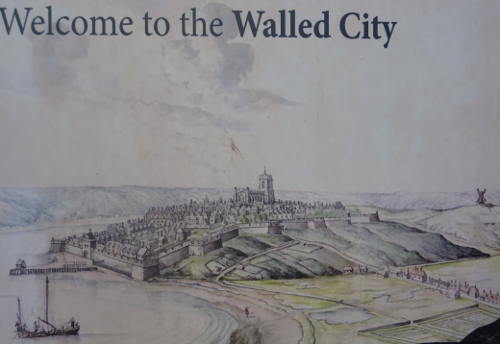
Derry is one of the oldest cities in Ireland. In 1613 the British colonists began to build the city inspired by the urban plan of London, calling it for this Londonderry.
In 5 years the defensive walls were built and still today it is possible to walk on them, go around the city center and going down in correspondence of the 4 access doors.
After over 400 years they are still completely intact and never scratched.
Useful and incredibly beautiful!

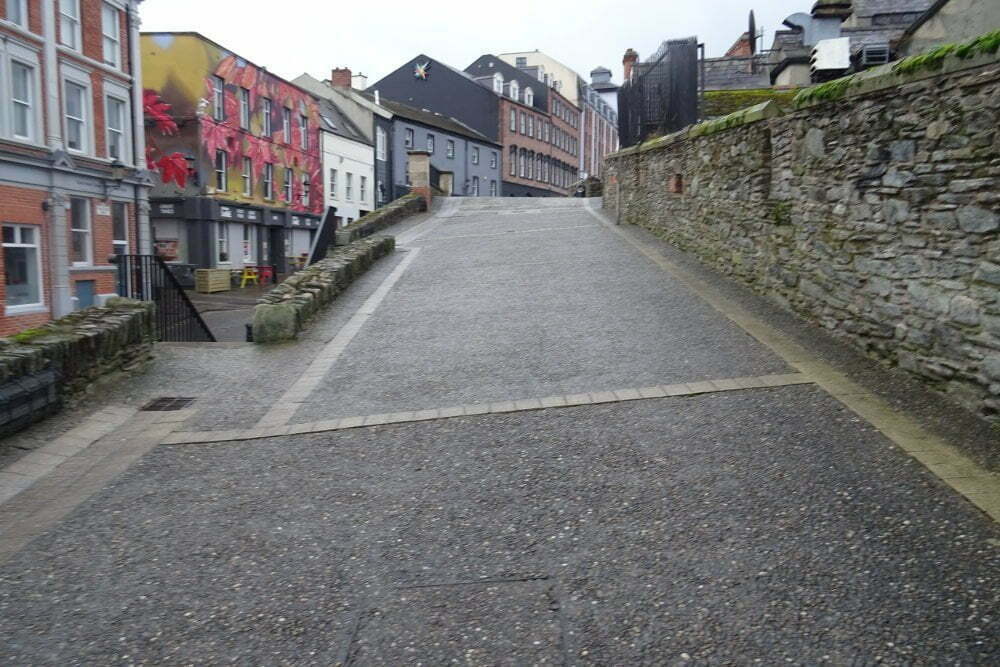

The walls are an aspect of city life, witnesses of historical and tragic events.
Never violated, they resisted against enemies armies and separated opposing city communities.
Having also had a defensive function, there are numerous loopholes and cannons arranged to guard the walls.
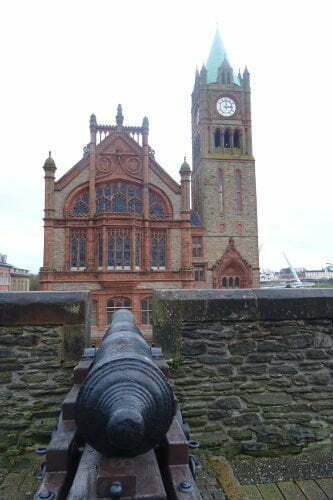
The beautiful Cathedral of San Columba, the founder of the city, was the first built in Europe after the Protestant Reformation.
It’s in stone and in Gothic style.

Leaving the walls and following the commercial Bishop Street, you reach the monument to the British who died during the two world wars.
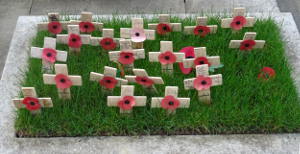
Continuing along Shipquay Street you reach the homonymous wall’s door.
Crossing it you find yourself in Guildhall Square.
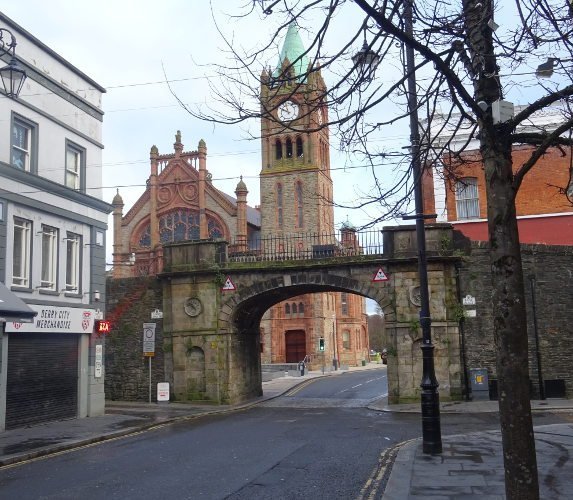
THE GUILDHALL
The Guildhall is the building where Derry and Strabane District Council meetings are currently done.
It’s considered a building of extreme importance for historical, architectural, cultural and political reasons.
In fact, there are many episodes that have marked this square.
On the afternoon of April 19, 1908 Easter day, only the clock tower was saved from a terrible fire that mysteriously spread from the roof and devastated the Guildhall in 3 hours.
On 1972 two IRA bombs destroyed much of the Guildhall and its interiors. Only one window remained intact.
Now its interior can be visited and includes an information center that helps you discover its history.
Interesting are the organ room and the windows along the corridors.

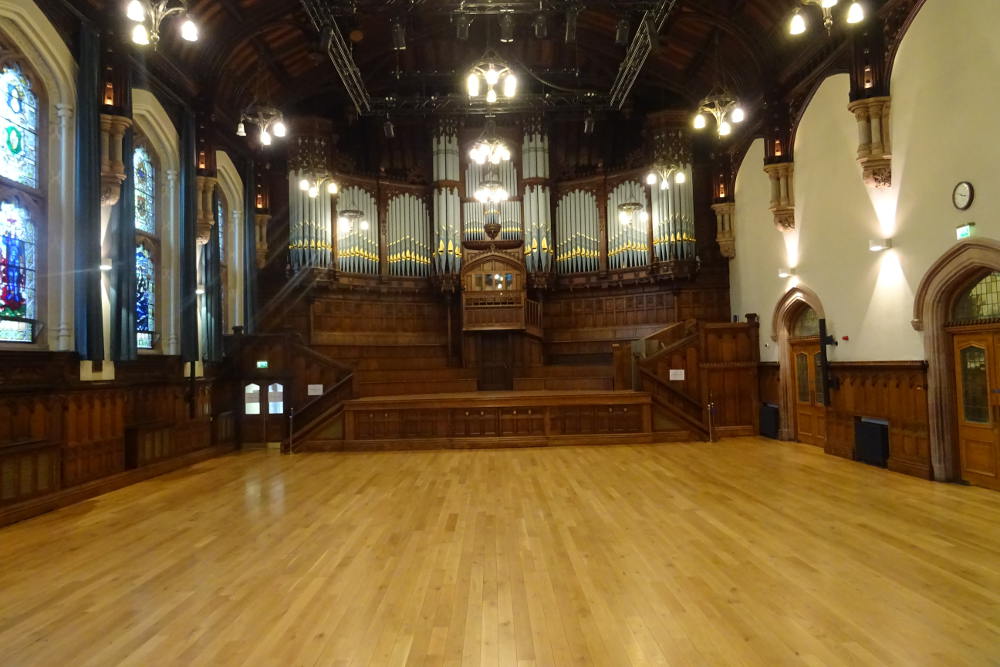

From the outside of the Guildhall, at the base of the stairs, leave the unmissable historical tour organized by those who lived and continues to live the Irish conflict.
You know Derry passing through the very narrow streets of the Bogside, the neighborhood where you can breathe the air of repressed but never defeated freedom, discovering the stories behind the murals and talking to the inhabitants.

This tour is a real full immersion in the republican atmosphere of the city.
Stories of those who have lost their relatives make it possible to imagine the arrival of the British Army, they make the bullets fired from the street and from the walls feel on their skin.
You live those moments, identify yourself with the dead, the wounded and the thousands of surviving protesters.
You can almost hear the screams, the shots, the smell of gas bombs.
To better understand the story with photos, videos and objects including the riddled clothes of the murdered, it is necessary to spend time in the Free Derry Museum.
DERRY: THE BOGSIDE
Around 1600 some English settled into the city walls area, occupying all power positions and behaving as if the Irish inhabitants of the Bogside were inexistent, despite being the clear majority.
his immediately determined the first conflicts between the two communities.
Electorally, the city was divided into 3 areas, organized only to guarantee the majority to unionist Protestants.
Until 1969, in fact, over 14,000 Irish nationalist votes could be worth 8 seats, 5,000 unionist votes guaranteed a majority of 12 seats.
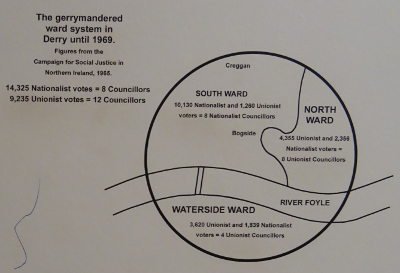
From 1940 arbitrary arrests were allowed without evidence, which flattened the nationalists, leaving them without leaders.
67% of Derry’s population was nationalist and Catholic, but the power of the English crown allowed Loyalist Protestants to maintain political and economic control.
Almost all of the Bogside was forced into unemployment and the consequent poverty.
From this situation, heavy conflicts exploded in 1968.
The United Kingdom launched the “Operation Motorman”: preventive arrests as a means of repression, a large forbidden area corresponding to the main streets of the Bogside defended by 21,000 soldiers supported by tanks and bulldozers.


The Bogside prepared to fight, raising barricades and inventing a historic motto: You are now entering Free Derry.
British soldiers had repeatedly tried to violate it by being photographed in front. Uselessly.
In over 50 years it has changed color several times to support struggles outside the urban context (in solidarity with the colonized Palestine, the bombed Gaza, the Basque prisons, for a search of peace among the oppressed populations etc.).
This writing in this wall, now known as the Free Derry Corner, has become the symbol of the Bogside that fights and doesn’t surrender.



In this daily climate of civil war we arrive at the symbolic date of Sunday 30 January 1972.
The Northern Irish Association for Civil Rights (NICRA) organized another demonstration against detention without trial.
The agreement was to keep it totally peaceful
15,000 people left the Bogside around 3:00pm.

Shortly after departure, the 1st Battalion Parachute Regiment, considered the elite of the British Army, fired on the unarmed crowd, shooting 26 protesters.
13 of them, including 6 minors, lost their lives on asphalt.
4 months later the fourteenth victim died, due to injuries sustained that day.
At least 17 were injured.
That Sunday has gone in history as The Bloody Sunday.
For the following decades, all the investigations defended the conduct of the British Army, claiming that the protesters were armed and attacked first.
This whole situation prompted most of the Irish people to unite, support, defend and help the IRA, the Irish Republican Army.
The Bogside was not alone in the battle for truth.
Every anniversary of Bloody Sunday, tens of thousands of people from around the world accompanied the families of the victims in the march to the truth.

The truth arrived on June 15, 2010, when British Prime Minister David Cameron admitted that what the Army did on January 30, 1972 was unjustified and unjustifiable.
All the victims were considered totally innocent.
The murals of the Bogside: The People’s Gallery
From 1993, artists have expanded the symbol of the Free Derry Corner mural, telling the story of the Bogside with works occupying entire facades of the buildings.
This of course with the support and contribution of the residents.
In The People’s Gallery revives more than 30 years of historical events in these streets.
Murals are almost all close and guides of the historical tour show them and describe their history.

The 14 victims of Bloody Sunday are remembered not only in a mural.
Relatives, friends, the Bogside and supporters from all over the world fought to defend their name, their honor and demand truth and justice.
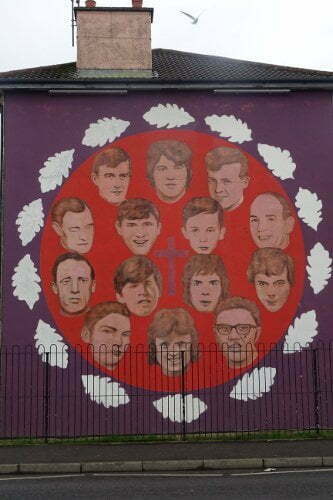
At 04.00 on 30 July 1972, thousands of British Army troops invaded the Bogside with the support of tanks and armored cars.
Artists chose to represent the ferocity of the attack showing soldier knocking down a house door.
We have to imagine what happened next.




The mural to Annette McGavigan represents all the children died in the troubles.
The young girl, 14 years old, was shot in the neck on September 6, 1971, by a British soldier while playing with friends.
She was the 100th victim of the war, the first underage murdered.
Despite the incessant efforts of the family, no investigation was ever opened.
No one was ever accused and sentenced for her death.
The defense ministry refused to release intelligence documents related to her murder.
In the original murals, only Annette stood out from the destruction.
The butterfly was not colorful but unfinished like Annette at the age she died.
The rifle was not broken, but still upside down and planted in the ground, as a sign of surrender.
In 2006 the mural was updated by the 3 artists, to depict a closer peace.
The colored butterfly now symbolizes rebirththe rifle broken the end of violence.



LONDONDERRY: THE FOUNTAIN
Here too, obviously, there are Protestant Unionist loyalist neighborhoods, especially in the area beyond the river. As in Belfast, the murals are dedicated to the British armed forces and the United Kingdom.




THE TRIP CONTINUES
The best way to get around the north of Ireland by public transport is to use the iLink Zona4. For £17 you can take all trains and buses for a day.
To see the Giant’s Causeway from Derry, you have to take bus 224 to Coleraine.
If you like a direct transfer (maybe between Derry and Belfast Airport), I recommend minivan airporter.co.uk
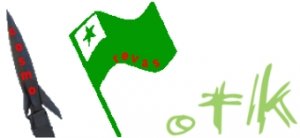
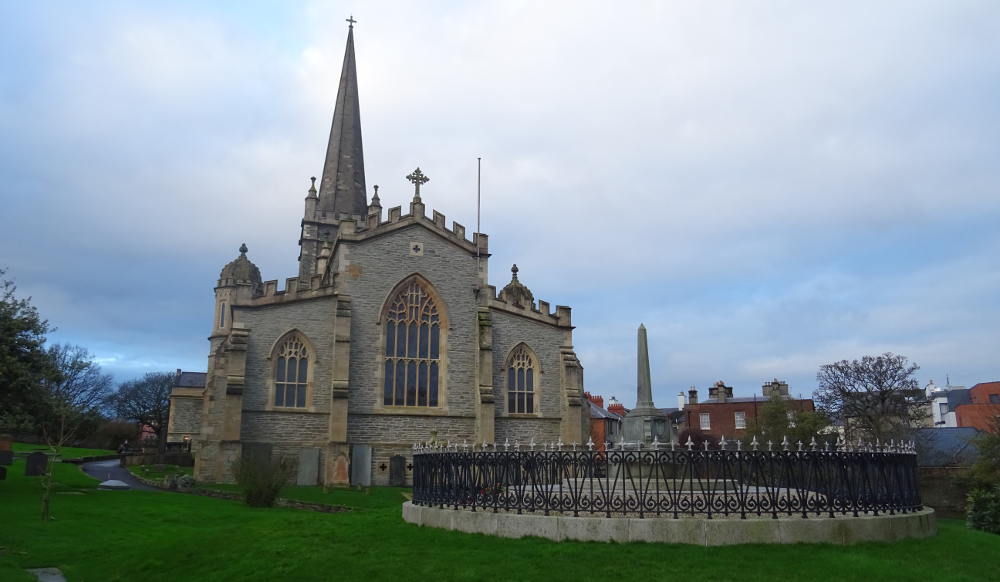



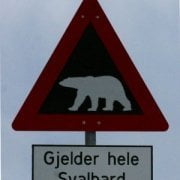





Leave a Reply
Want to join the discussion?Feel free to contribute!